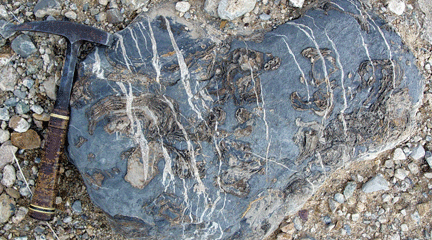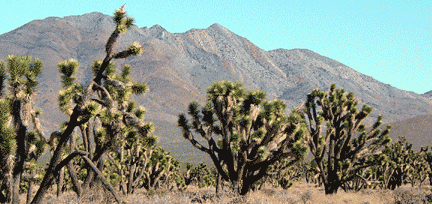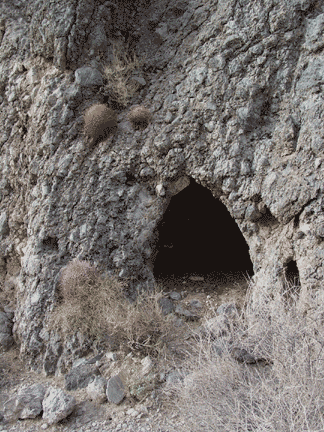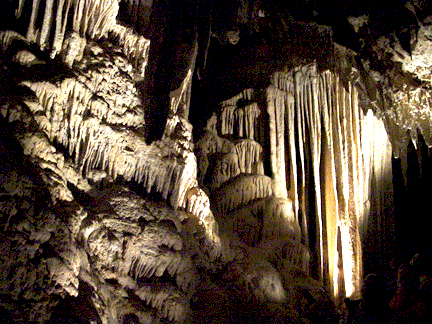Introduction to the
Mojave National Preserve
General Mojave
Geologic History
Changing Climates
& Ancient Lakes
Carbonate Rocks and Associated Landforms
In the Mojave National Preserve, carbonate sedimentary rocks of Proterozoic and Paleozoic age (consisting of limestone and dolostone) crop out throughout the Clark Mountains, the Mescal Mountains, in the northern Ivanpah Range, in the central portion of Providence Mountains, and elsewhere. Carbonate rocks originally form from limey sediments consisting of the calcareous skeletal remains of algae and invertebrate shell material or precipitates directly from agitated, warm seawater (as on a shallow continental shelf in a warm climate). Most ancient limestones formed from planktonic algae, but in late Paleozoic time coralline reefs became significant producers of carbonate sediments. Limestone consists dominantly of the mineral Calcite-CaCO3, whereas dolostone consists dominantly of the mineral dolomite-CaMg(CO3)2. Dolomite is typically a secondary mineral replacement of original calcite material. Ancient carbonate rocks like those in the Mojave region tend to be enriched in dolomite. Below are examples of common fossiliferous carbonate rocks of Paleozoic age from the Mojave region.
 |
| Oncolites (algal limestone balls) float in a carbonate-mud matrix in the Cambrian-age Chambless Formation. This easy-to-recognize oncolite-bearing limestone formation crops out in many areas throughout the Mojave National Preserve region. These nearly spheroidal oncolites formed by algae and/or cyanobacterial growth in shallow warm marine waters of a carbonate platform environment. |
 |
| A boulder of a fossiliferous limestone displays stromatoporoids and corals of early Devonian age (Sultan Formation). Boulders like this one are not uncommon in alluvial fans downstream from the Paleozoic age sedimentary rock belt exposed in the Providence Range. |
 |
| An expansive Joshua-tree forest covers a pediment surface (along Cima Road). In the distance, steeply dipping and folded sedimentary rocks (mostly limestone and dolomite) of late Proterozoic and Paleozoic age crop out throughout the Mescal Range. |
In contrast to other types of rocks, carbonate rocks tend to be fairly resistant to erosion in arid climate conditions. The ancient carbonate rocks in the Mojave region are typically both dense and brittle and tends to be heavily fractured at the surface. At depth, fractures in carbonate tend to heal over time as the rock gradually flows under extreme pressure, and as calcite and other minerals precipitate in crevasses over time. Throughout the desert southwest, deep canyons carved into carbonate rock display collapse breccia, which are massive surficial deposits that consist of broken fragments of limestone and dolostone tightly cemented in a carbonate matrix.
 |
A small cavern occurs in brecciated carbonate rocks that crop out along an unnamed wash draining from the western Providence Mountains (8 miles directly east of Kelso Depot). "Collapse breccias" like this are prevalent in the Bonanza King Formation. This formation is nearly 300 meters thick and consists of algal limestone and dolomite of Middle Cambrian age (around 550 million years). The age of the "collapse" is unresolved, but may actually be an active physical-chemical process that affects large carbonate units in the desert surface environment. They may actively be "flowing" down slope under the force of gravity. This breccia is probably an early Quaternary-age landslide deposit that has been reconsolidated (cemented) by groundwater interaction with the carbonate rock. |
Carbonate rocks dissolve in freshwater, with calcite being more soluble than dolomite. With each precipitation event, traces of carbonate material will dissolve and migrate with flowing water. Dissolution occurs along fractures in the subsurface producing caverns. As water evaporates at the surface, calcite will precipitate again, cementing sediments on alluvial fans to form a durable calcareous crust (called caliche). Calcite is a major component of playa mud deposits. Varieties of freshwater limestone deposits called tufa and travertine form around springs and in former wave-influenced lake shore zones. In caverns, travertine deposits are called speleothems (which include stalagmites, stalactites, columns, flowstone, and other features).
 |
| Mitchell Caverns in the Providence Mountains State Recreation Area has been developed for commercial visitation. The cavern formed in limestone of Late Paleozoic age (Pennsylvanian- and Permian-age Bird Springs Formation). The cavern formed long ago when the bedrock was constantly exposed to groundwater, allowing dissolution of the limestone to occur. Today, the cavern is high and dry; it is more than 500 meters above the valley floor and a constant supply of groundwater. |
 |
| Travertine tapestries, flowstone, and other speleothems gradually form where groundwater enters the cavern and evaporates, leaving behind calcium carbonate. Features like this one probably took many thousands of years to form. Only a small percentage of the speleothems in Mitchell Caverns are actively forming. |
In the Mojave region, alluvial deposits derived from areas with carbonate bedrock tend to consist of blocky, unevenly sorted sediments. In many areas chert layers and metasandstone layers occur interbedded within the bedrock. These more siliceous materials tend to be more resistant to both mechanical and chemical weathering forces, and as a result, alluvial surfaces and sediments down slope from carbonate rock source areas tend to be enriched in these associated siliceous materials. Carbonate mountains are the highest and steepest without exception. These areas are prone to stronger flood forces, bigger canyons, more precipitation, coarser fans, steeper fans, and hense, greater risk for debris flow activity.

